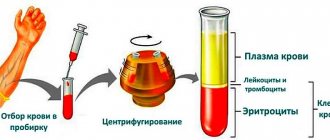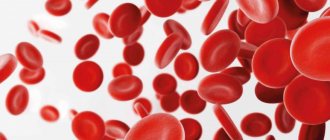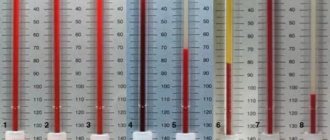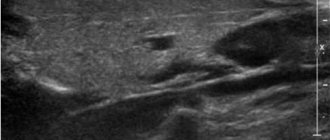MCV in a blood test is one of the most important erythrocyte indices. It reflects the average volume of a red blood cell and is calculated by dividing the hematocrit by the number of red blood cells. The result is expressed in cubic microns or femtoliters.
Another way to obtain this indicator is to multiply the hematocrit by 10 and divide the resulting number by the number of red blood cells contained in one cubic millimeter of blood.
It is important to consider that in some cases the mcv test will produce invalid data. For example, in sickle cell disease, large numbers of abnormal, misshapen red blood cells circulate in the bloodstream. Therefore, the indices obtained by calculation will in this case be uninformative.
Indications for analysis
MCV blood test is not the only one. To clarify the diagnosis, the therapist may require a retake or refer it for additional tests.
MCV is informative in two cases:
- in order to diagnose one of the types of anemia;
- to determine the type of water-salt imbalance. People are often sent for such an analysis if they have various intestinal infections, acute respiratory diseases and ARVI.
Other, no less serious, reasons for getting tested may be:
- failure of the hormonal system;
- metabolic problems;
- overweight;
- increased blood sugar or diabetes;
- a sharp and causeless decrease in the level of the immune system.
MCV analysis results often help identify such deviations:
- anemia of normochromic type. It is fixed when pathologies appear in the bone marrow, sometimes caused by chronic diseases;
- macrocytic type anemia. It is characterized by an excessive increase in mcv. Red blood cells increase in size due to insufficient amounts of vitamin B and folic acid;
- microcytic anemia. In this case, the disease occurs due to a lack of iron in the blood.
What is the norm and what is considered a deviation
A normal value is considered when the MCV is between 80 and 100 femtoliters. The red blood cell in this case is a normocyte.
If the average volume of a red cell is less than 80 fl, it is a microcyte. Well, if the volume is more than 100, then such an erythrocyte is called a macrocyte.
Accordingly, microcytosis is distinguished when a large number of microcytes are detected in the blood. Low hemoglobin is characteristic. Macrocytosis is characterized by an increased content of macrocytes in the analysis.
Anisocytosis is the presence of red blood cells of different sizes and shapes.
In newborns and children under one year old, the norm is 70-110 femtoliters. With age, this indicator is compared with that of adults
Normal MCV values
| Age, gender | Mean erythrocyte volume, MCV, fl | |
| Children | ||
| 1 day - 14 days | 88,0 — 140,0 | |
| 14 days - 4.3 weeks | 91,0 — 112,0 | |
| 4.3 weeks - 8.6 weeks | 84,0 — 106,0 | |
| 8.6 weeks - 4 months | 76,0 — 97,0 | |
| 4 months – 6 months | 68,0 — 85,0 | |
| 6 months – 9 months | 70,0 — 85,0 | |
| 9 months - 12 months | 71,0 — 84,0 | |
| 12 months - 5 years | 73,0 — 85,0 | |
| 5 years - 10 years | 75,0 — 87,0 | |
| 10 years - 12 years | 76,0 — 90,0 | |
| 12 years - 15 years | Women | 73,0 — 95,0 |
| Men | 77,0 — 94,0 | |
| 15 years - 18 years | Women | 78,0 — 98,0 |
| Men | 79,0 — 95,0 | |
| 18 years - 45 years | Women | 81,0 — 100,0 |
| Men | 80,0 — 99,0 | |
| 45 years - 65 years | Women | 81,0 — 101,0 |
| Men | 81,0 — 101,0 | |
| 65 years - 120 years | Women | 81,0 — 102,0 |
| Men | 83,0 — 103,0 | |
In children under 10 years of age, the index may fluctuate and be inaccurate; later it returns to normal (80-100 fl).
General (clinical) blood test: interpretation and norm
A complete blood count provides essential information about the types and numbers of blood cells, especially red blood cells, white blood cells and platelets. Using a general blood test, the treating doctor can detect the nature of symptoms such as weakness, fatigue, and bruising. A complete blood count is used to diagnose anemia, infection and many other disorders.
A general (clinical) blood test includes the following indicators:
- Absolute white blood cell count ( WBC ). White blood cells protect the body from infection. If an infection develops, these cells attack and destroy bacteria, viruses, or other pathogenic organisms. White blood cells are larger in size than red blood cells, but their number is less. When a person gets sick, the number of white blood cells increases very quickly. Sometimes white blood cell counts are used to detect infection or to evaluate the effectiveness of cancer treatment.
- Determination of the ratio of different types of white blood cells (leukogram). The main types of leukocytes are neutrophils, lymphocytes, monocytes, eosinophils and basophils. Counting immature neutrophils, also called band neutrophils, is part of this test. The number of each cell type can provide important information about the health of the immune system. Too high or too low the number of one type of cell may indicate an infection, an allergy or toxic reaction to a drug or chemical, or various diseases such as leukemia.
- Absolute red blood cell count ( RBC ). Red blood cells carry oxygen from the lungs to the rest of the body. They also carry carbon dioxide back to the lungs for exhalation. When the level of red blood cells is low (anemia), the body does not receive enough oxygen. When levels are high (polycythemia), there is a risk of red blood cell clots that can block tiny blood vessels (capillaries), also making it difficult to carry oxygen.
- Hematocrit ( HCT , precipitated red blood cell volume, PCV ). This test measures the volume of blood per red blood cells. For example, a hematocrit value of 38 means that 38% of the blood is red blood cells. Hematocrit and hemoglobin are the two main tests for detecting anemia or polycythemia.
- Hemoglobin ( Hgb ). Hemoglobin molecules are found in red blood cells; they carry oxygen and give the blood its red color. A hemoglobin test measures the level of hemoglobin in the blood and shows how the body copes with transporting oxygen.
- Erythrocyte index. There are three red blood cell indices: mean erythrocyte volume (MCV), mean erythrocyte hemoglobin content (MCH) and mean erythrocyte hemoglobin concentration (MCHC). All of them are calculated using special equipment, and the numbers are derived from other indicators of a general blood test. MCV reflects the size of red blood cells, MCH is the average hemoglobin content in an individual red blood cell, MCHC is the hemoglobin concentration in an individual red blood cell. These indices are used in diagnosing various types of anemia. The red blood cell distribution width (RDW) index is also calculated, which reflects the difference in size and shape between cells.
- Absolute platelet count. Platelets are the smallest type of blood cell. They play an important role in the blood clotting process. If bleeding occurs, the platelets are activated and bind together, forming a plug that prevents bleeding. If the number of red blood cells is insufficient, there is a risk of uncontrolled bleeding. If there is an excess amount, there is a risk of thrombus formation in a blood vessel. In addition, platelets can be involved in the formation of sclerotic plaques on artery walls (atherosclerosis).
- Mean platelet volume ( MPV ). This indicator reflects the average value of the measured platelet volume. MPV is used in conjunction with platelet count to diagnose certain diseases. If the platelet count is normal, the MPV may be low or high.
Your doctor may also order a blood smear microscopy at the same time as your complete blood count, but this is not part of your routine blood test. For this test, a drop of blood is placed on a plate and diluted with dye. The plate is examined under a microscope, noting the number, size and shape of red blood cells, white blood cells and platelets. Differences in the shape or size of blood cells can indicate various diseases, such as leukemia, malaria or sickle cell disease.
A clinical blood test is carried out for the following purposes:
- Finding the cause of symptoms such as fatigue, weakness, fever, bruising, or weight loss
- Diagnosis of anemia
- Establishing the amount of blood lost during bleeding
- Diagnosis of polycythemia
- Diagnosis of infections
- Diagnosis of blood diseases, such as leukemia
- Monitoring the body's response to drug treatment and radiation therapy.
- Monitoring the blood cell response to abnormal bleeding.
- Screening of indicators before surgery.
- Tracking high or low levels is used to detect various diseases, such as high eosinophil levels that may indicate allergies or asthma.
A complete blood count is performed as part of a routine medical examination. A complete blood count provides valuable information about the overall condition of the body and health.
Preparing for the examination
No special preparation required.
How is the examination carried out?
- The shoulder is tightened with an elastic tourniquet to stop the blood flow. The veins under the tourniquet become larger, making it easier to insert the needle.
- The puncture site is cleaned with alcohol.
- The needle is inserted into the vein. Sometimes more than one injection is required.
- A blood collection tube is attached to the needle.
- When enough blood has been collected, the tourniquet is removed.
- After the needle is removed, a cotton swab is applied to the injection site.
- The area should be pressed and a bandage applied.
If a baby's blood is being tested, a heel prick is done instead of drawing blood from a vein.
Feelings during the procedure
A blood sample is taken from a vein in the arm. The forearm is wrapped with an elastic band, so there may be a feeling of tightness. You may not feel any pain from the needle, but sometimes there will be a slight burning sensation or pain.
Complications
When taking blood from a vein, the chance of complications occurring is very small.
- There may be a slight bruise. By pressing the tampon to the puncture site for a few minutes, you can reduce the chance of its occurrence.
- In rare cases, the vein may become swollen, this is called phlebitis. The problem can be treated with several warm compresses.
- Continuous bleeding may occur in patients with blood disorders. Taking medications such as aspirin, warfarin (such as Coumadin), and other blood thinners increases the chance of bleeding. Tell your doctor before taking a sample if you have problems with blood clotting or are taking blood-thinning medications.
results
A complete blood count provides important information about the types of blood cells - red blood cells, white blood cells, platelets - and their numbers. A complete blood count helps determine the cause of various symptoms such as weakness, nausea, bruising and is used in the diagnosis of various diseases - anemia, infections and many others.
Normal results
IMPORTANT! The normal values, or range of normal values, given here are average values. These vary depending on the laboratory, so where you are being tested will have different readings. The laboratory report should contain information about the reference range used. In addition, overall health and other factors are taken into account when analyzing the results. Therefore, a value that does not fit into the range presented here may be normal for you personally.
The normal range depends on your age, gender, type of blood sample, and how high above sea level the area where you live is. The doctor can use all the indicators of the general blood test when checking the condition of the body. For example, the number of red blood cells, hemoglobin, hematocrit are the main indicators in diagnosing anemia, but erythrocyte indices and smear microscopy also help detect this disease and can show the possibility of its occurrence.
To assess the number and size of leukocytes, the doctor takes into account the results of counting the number of cells and the ratio of their types. To see if there are too many or few cells of a certain type, the doctor compares their number and percentage. There is a norm for each type of leukocyte.
Indicators may change during pregnancy. During each trimester, your doctor should report changes in your normal range.
| Absolute white blood cell count ( WBC ) | |
| Men and non-pregnant women: | 5,000–10,000 WBC per cubic mm (mm3) or 5.0–10.0 x 109 WBC per 1 liter (L) |
| The ratio of different types of leukocytes | |
| Neutrophils: | 50%–62% |
| Band neutrophils: | 3%–6% |
| Lymphocytes: | 25%–40% |
| Monocytes: | 3%–7% |
| Eosinophils: | 0%–3% |
| Basophils: | 0%–1% |
| Absolute red blood cell count ( RBC ) | |
| Men: | 4.5–5.5 million RBC per µl or 4.5–5.5 x 1012/l |
| Women: | 4.0–5.0 million RBC per µL or 4.0–5.0 x 1012/L |
| Children: | 3.8–6.0 million RBC per µL or 3.8–6.0 x 1012/L |
| Newborns: | 4.1–6.1 million RBC per µL or 4.1–6.1 x 1012/L |
| Hematocrit (HCT) | |
| Men: | 42%–52% or 0.42–0.52 of the total volume |
| Women: | 36%–48% or 0.36–0.48 of total volume |
| Children: | 29%–59% or 0.29–0.59 of the total volume |
| Newborns: | 44%–64% or 0.44–0.64 of total volume |
| Hemoglobin (Hgb) | |
| Men: | 14–17.4 grams per deciliter (g/dL) or 140–174 grams per liter (g/L) |
| Women: | 12–16 g/dl or 120–160 g/l |
| Children: | 9.5–20.5 g/dl or 95–205 g/l |
| Newborns: | 14.5–24.5 g/dl or 145–245 g/l |
Typically, a normal hemoglobin level is one third of the hematocrit level.
| Red blood cell indices | |
| Mean erythrocyte volume ( MCV ) - Adults: | 84–96 femtoliters (fl) |
| Mean erythrocyte hemoglobin content ( MCH ) - Adults: | 28–34 picograms (pg) per cell |
| Mean erythrocyte hemoglobin concentration ( MCHC ) - Adults: | 32–36 grams per deciliter (g/dL) |
| Red blood cell distribution width by volume ( RDW ) | |
| Norm: | 11.5%–14.5% |
| Absolute platelet count | |
| Adults: | 140,000–400,000 platelets per mm3 or 140–400 x 109/L |
| Children: | 150,000–450,000 platelets per mm3 or 150–450 x 109/L |
| Mean platelet volume (MPV) | |
| Adults: | 7.4–10.4 µm3 or 7.4–10.4 fl |
| Children: | 7.4–10.4 µm3 or 7.4–10.4 fl |
| Blood smear microscopy | |
| Norm: | Normal indicators of the number, shape, color and size of blood cells. |
High performance
Absolute red blood cell count (RBC)
- Conditions and habits that cause high red blood cell counts include smoking, exposure to carbon monoxide, long-term lung disease, kidney disease, some cancers and heart disease, alcoholism, liver disease, a rare bone marrow disease (polycythemia vera), or rare problems related to with hemoglobin, which are associated with the transfer of oxygen.
- Diseases related to the water component of the body can also cause high red blood cell counts. These include dehydration, diarrhea, vomiting, increased sweating, and taking diuretics. Lack of fluid in the body causes red blood cell counts to appear high. This is sometimes called pseudopolycythemia.
Absolute white blood cell count (WBC)
- Causes of high white blood cell counts include infection, inflammation, tissue damage (for example, due to a heart attack), kidney failure, lupus, tuberculosis, rheumatoid arthritis, malnutrition, leukemia, and cancer.
- Taking costosteroids and certain medications, underactive adrenal glands, problems with the thyroid gland, and removal of the spleen can also cause an increase in white blood cell levels.
Absolute platelet count
- High platelet levels can occur due to bleeding, iron deficiency, cancer and bone marrow problems.
Low performance
Absolute red blood cell count (RBC)
- With anemia, the level of red blood cells decreases. Anemia can be caused by heavy menstrual bleeding, stomach ulcers, colorectal cancer, inflammatory bowel disease, tumors, Addison's disease, thalassemia, lead poisoning, sickle cell disease, or a reaction to certain chemicals and medications. One reason for low red blood cell counts may be removal of the spleen.
- Not getting enough folic acid or vitamin B12 can also cause anemia, such as pernicious anemia, which causes problems absorbing vitamin B12.
- Red blood cell indices and smear microscopy can help find the cause of anemia.
Absolute white blood cell count (WBC)
- Low white blood cell counts may be caused by chemotherapy and reaction to drug treatment, aplastic anemia, viral infections, malaria, alcoholism, AIDS, lupus, Cushing's syndrome.
- An enlarged spleen can reduce white blood cell counts.
Absolute platelet count
- Low platelet levels can be caused by pregnancy, immunopathological thrombocytopenic purpura and other diseases that affect the process of generating platelets or destroy them.
- An enlarged spleen can reduce platelet counts.
What can affect the results of the examination?
Reasons why the analysis is not possible or the results will be incorrect:
- When drawing blood, your arm was tied with an elastic tourniquet for a long time.
- Taking drugs that cause low platelet counts, such as certain antibiotics, steroids, thiazide diuretics, chemotherapy drugs, quinidine, meprobamate.
- Very high levels of white blood cells or fats (triglycerides) can cause falsely high hemoglobin levels.
- With an enlarged spleen, the level of platelets (thrombopenia) or white blood cells may be reduced; this condition can also cause some types of cancer.
- During pregnancy, the level of red blood cells is often reduced, and less often, the level of white blood cells is increased.
On a note:
- The absolute white blood cell count can reach up to 2000 WBC per microliter due to exercise, stress or smoking.
- Children tend to have higher levels of white blood cells than adults.
- Often, a red blood cell count test includes:
- Erythrocyte sedimentation rate (ESR). The ESR test measures how quickly red blood cells settle to the bottom of a tube. During inflammatory processes occurring in the body (for example, in the presence of infection or cancer), red blood cells settle more slowly than under normal conditions. Using ESR analysis, inflammatory diseases can be diagnosed if the blood test results are normal.
- Analysis of reticulocyte content. This is an analysis of the number of young red blood cells in a blood sample. As a rule, the content of reticulocytes is lower compared to the content of mature red blood cells. However, recent bleeding or destruction of mature red blood cells may cause increased reticulocyte production. This test is done to detect certain types of anemia and screen for the body's response to treatment.
- Hematocrit measurements may vary depending on the assay method and equipment used.
MCV is higher than normal
If the results are above normal, this indicates the development of macrocytic anemia. It can be directly related to diseases such as:
- drug intoxication;
- food poisoning;
- problems with the thyroid gland;
- lack of iodine or iron in the body;
- liver dysfunction;
- oncological process of red bone marrow;
- long-term alcoholism;
- disruption of the pancreas.
An increase in mcv can be caused by:
- long-term use of birth control pills that affect hormonal levels;
- addiction to cigarettes and tobacco products;
- prolonged contact with toxic substances (work in hazardous industries);
- taking medications that increase the level of mcv in the blood.
If left untreated, macrocytic anemia can lead to frequent fainting, poor health, and low hemoglobin levels in the blood. Particularly at risk are:
- people who eat poorly, lead a sedentary lifestyle and ignore exercise;
- patients with chronic liver failure;
- people with a genetic predisposition to the disease;
- men over fifty-five years of age who abuse alcohol.
Experts identify some signs by which one can understand that a person’s red blood cell volume is too high:
- unhealthy pale lips;
- abdominal pain for no particular reason, which appears very often;
- the presence of tachycardia (heartbeat too fast), even when the person is at rest;
- skin with a yellowish tint.
If you notice similar symptoms or detect an increased level of mcv in the blood, you must immediately consult a general practitioner for appropriate treatment.
Causes of elevated MCV
The average volume of red cells is increased when:
- liver diseases;
- hemolytic anemia;
- development of water-electrolyte imbalance in the form of hypotonic overhydration, which is possible with kidney diseases;
- macrocytic and megaloblastic anemia;
- deficiency of folic acid and vitamin B12;
- myelodysplastic syndrome.
Anemia cannot be ruled out when MCV is not higher than normal. For example:
- after bleeding;
- with hemolytic anemia;
- for some acute poisonings.
MCV below normal
Tests showing that the volume of red blood cells is below normal also indicates pathology. Experts name a number of reasons that can lead to such results:
- genetic predisposition;
- insufficient amount of water consumed;
- development of various types of anemia;
- lead intoxication;
- the presence of malignant formations, tumors in the body;
- taking medications that affect test results.
In medical circles, a disease in which the level of red blood cells in the body decreases is commonly called microcytic anemia. The peculiarity of the disease is that red blood cells do not perform their transport function, i.e. they do not deliver oxygen and other useful substances to the body’s cells in the required quantities.
With this pathology, a characteristic clinical picture is observed:
- constant fatigue;
- increased irritability, nervousness;
- decreased concentration and performance;
- absent-mindedness;
- memory impairment.
A decrease in the volume of red blood cells is always observed with various types of blood loss.
Pregnancy and mcv
During pregnancy, due to the body's increased consumption of iron, microcytic anemia can develop. This condition can negatively affect both the health of the unborn child and the well-being of the mother.
Some experts are convinced that mcv indicators are directly related to a person’s psychological state.
Preparing for analysis
In most cases, blood for analysis is taken from a vein. It is permissible to take capillary blood from children under 3 years of age and from adults for special indications. The analysis is taken in the morning, on an empty stomach; the fasting period should be at least 8 hours.
Before blood sampling, it is forbidden to eat food or any drinks; you can drink plain water. There is no need to follow a diet a few days before the test, but you should exclude alcoholic drinks and fatty foods. It is undesirable to be exposed to high physical and psycho-emotional stress, which may affect the reliability of the analysis results.
In the process of preparing for the blood sampling procedure, the patient should be warned about possible unpleasant sensations when applying a tourniquet and during vein puncture.
Features of the analysis
Today, the mcv test is included in the general blood test or can be performed separately from other indicators. To donate blood, the patient must come to the treatment room, where a laboratory technician or nurse will take blood samples from a finger or vein. Blood sampling is carried out in accordance with all sanitary and epidemiological regulations (SanPiN).
The patient is required to comply with the following rules:
- You need to donate blood on an empty stomach (5-12 hours after your last meal);
- at the time of donation, the woman should not be menstruating;
- feeling normal. It is prohibited to take blood samples if the patient is not feeling well, is in a coma or is in cardiac shock.
A little about anisocytosis
Anisocytosis is the presence of red blood cells of different sizes in the blood - from microcytes to macrocytes. Quantitatively, the distribution of red blood cells by volume is expressed in a special index, designated RDW.
This is what the distribution width of erythrocytes by volume curve looks like in the analysis
Red blood cell heterogeneity by volume (RDW) shows the deviation from the standard volume, expressed as a percentage.
Anisocytosis can be determined by a blood smear under a microscope, but the exact characteristics of these indicators are obtained using hematological analyzers. Interpretation of the results is carried out by laboratory diagnostic doctors together with MCV and facilitates the diagnosis of anemia.
Normally, the width of the distribution of red blood cells is 11.5-14 percent. You should know that if MCV is reduced with normal RDW, then this is typical for blood transfusion, removed spleen, and thalassemia.
If MCV is elevated with normal RDW, then most likely there is liver pathology. If RDW is elevated and MCV is below normal, beta thalassemia, iron deficiency, or red blood cell sludge may be suspected.
If suddenly both indicators are higher than normal, then we can assume cold agglutination, vitamin B12 deficiency or impaired absorption. This combination is also typical after a course of chemotherapy for cancer.
What to do if the indicator deviates from the norm
If the results of a general blood test show a deviation from the norm in the average size of erythrocyte units in the direction of increasing or decreasing their size, the following steps must be taken:
- together with your doctor, try to establish the causative factor influencing the change in red blood cells;
- streamline the daily routine, balance the diet, saturating it with foods containing a sufficient amount of iron, iodine, vitamin B6, B12 (veal, nutria meat, rabbit, turkey, legumes, nuts, ocean fish, seaweed, shellfish, crustaceans);
- take medications that will be prescribed by your doctor;
- completely stop using alcoholic beverages, tobacco products and drugs;
- Avoid a sedentary lifestyle, engage in cycling, athletics, and swimming.
MCV as part of a blood test is an indicator that tends to change under the influence of environmental factors. Therefore, in order for the average cell volume to reach optimal levels, an integrated approach is required using drug therapy, compliance with the instructions of the attending physician and dietary standards.
Article design: Mila Friedan
Comparative study
To ensure a comparative study on MCV, simultaneous sampling of capillary (ring finger) and venous blood is performed.
The laboratory specialist places both samples into the analyzer and, based on the diagnostic results, checks the data obtained. This research method makes it possible to eliminate the factor of incorrect operation of medical equipment and minimize the likelihood of obtaining a false result.
Reasons for increasing MCV
A violation of the MCV norm in the direction of an increase in the average cell size may indicate the occurrence of blood diseases or indicate a pathological condition of internal organs.
The following reasons for increased MCV in the bloodstream are identified:
- intoxication of the body with antibacterial drugs or medications included in the group of antidepressants;
MCV in blood tests increases with illness - bacterial infection that caused extensive inflammation;
- uncontrolled use of steroid drugs or contraceptives based on synthetic hormones;
- severe liver diseases in the form of cirrhosis, viral or intoxicating hepatitis;
- long-term use of strong alcoholic drinks;
- autoimmune pathologies, which are expressed in disruption of the process of red blood cell synthesis;
- prolonged contact with chemicals of toxic etiology, the compounds of which saturate the blood;
- iron and iodine deficiency in the body caused by poor diet or other factors;
- diseases of the thyroid gland associated with insufficient or excessive synthesis of hormones.
Most patients with MCV levels exceeding the norm experience characteristic symptoms in the form of causeless pain in the abdominal cavity, pale skin (if liver pathology is present, yellowing of the skin and whites of the eyes is possible), increased heart rate, and shortness of breath.
At risk are people who lead a sedentary lifestyle, as well as those with a genetic predisposition.
Reasons for the decrease in the indicator
A decrease in the average size of erythrocyte units is no less dangerous than an increase in blood cell parameters. The internal organs and tissues of the body begin to experience an acute lack of nutrients, oxygen starvation of cells and premature death occurs. A person quickly loses weight, and dysfunction of internal organs and systems develops.
The reasons for the decrease in MCV are the following factors:
- porphyria or a hereditary predisposition to the body producing defective cells;
- heavy metal poisoning (most often a similar clinical picture occurs in people who have been in contact with lead vapor);
- the presence of cancer of the blood or internal organs;
- severe dehydration of the body;
- long-term use of medications, the side effect of which is a decrease in the average volume of red blood cells;
- anemia of all types.
People who have a low MCV complain of constant fatigue, loss of physical strength, become absent-minded, cannot concentrate, and the thought process is disrupted.
The nervous system exhibits symptoms such as increased irritability, depression, rapid mood swings, and memory impairment. If these signs appear, you should consult a doctor as soon as possible.
Classification and causes of microcytic (MCV lowered) anemia
Anemia is a group of diseases of the human circulatory system, which is expressed in a decrease in hemoglobin levels, as well as a reduction in the average volume of red blood cells.
This pathology is classified according to the causative factors that provoked its development, namely:
- allastic - caused by systemic dysfunction of the bone marrow, as a result of which the process of synthesis and maturation of blood cells is disrupted;
- iron deficiency - there is a decrease in the rate of hemoglobin production, since the patient’s body does not receive enough iron;
- thalassemia is a hereditary type of anemia that occurs due to the fact that the body is not able to form sufficiently strong polypeptide bonds in the protein compounds of hemoglobin;
- hemolytic - develops when the level of dead cells exceeds the number of new red blood cells.
A type of microcytic anemia is taken into account by the attending physician when making a diagnosis, as well as during the formation of a therapeutic course. Eliminating the pathological causes of the disease is a prerequisite for successful treatment.
Cell Variability
Under the constant influence of a number of environmental factors, the occurrence of biochemical and physiological adaptation of blood cells cannot be ruled out.
Variability in the average volume of red blood cells is possible under the following conditions:
- prolonged abuse of alcoholic beverages (alcohol addiction);
- daily contact with toxic substances;
- eating excess amounts of protein foods;
- deficiency of foods containing iron and vitamin B12.
Sooner or later, physiological variability of cells leads to the development of diseases of the blood, as well as tissues of internal organs that suffer from an increased or decreased MCV. Most often, the pathological state of cells leads to the development of blood cancer.
Red blood cells and their function in the body
Erythrocytes are red blood cells containing hemoglobin. Their main function is the transport of oxygen and carbon monoxide between the lungs and the tissues of other organs. In addition, red blood cells participate in the reactions of the immune system, play a significant role in maintaining the acid-base balance, and serve as a means of transport of nutrients (glucose, amino acids, salts, fatty acids) and breakdown products (uric acid, urea, ammonia, creatine).
Red blood cells are produced in the bone marrow. Their life cycle is 120 days, after which the red blood cells are metabolized by the cells of the liver, spleen and bone marrow. They are replaced by young forms of red blood cells called reticulocytes. Before entering the microvasculature, cells go through several stages of development, during which their shape, size and chemical composition change. For normal synthesis of red blood cells, a sufficient supply of vitamin B12, iron and folic acid is necessary.
Mature erythrocytes are anucleate cells that have the shape of biconcave discs, which allows them to penetrate into the narrowest and curved areas of the vascular bed. Due to the plasticity of red blood cells, the viscosity of blood in small capillaries is much less than in large ones.
The average diameter of a red blood cell in an adult is between 6.8 and 7.5 microns. Red blood cells with a diameter of less than 6.8 microns are called microcytes, and a condition in which the size of peripheral blood red blood cells is significantly smaller than normal means the presence of microcytosis. The presence in the blood of abnormally large red blood cells (macrocytes) with a diameter of more than 8 microns allows us to suspect macrocytosis in the patient.
The determination of the erythrocyte index is performed as part of a general blood test, but can also be prescribed as a separate study.
The average volume of erythrocytes has diagnostic value in assessing micro- and macrocytosis; it is used in calculating the average content and concentration of hemoglobin in erythrocytes.
MCV in blood test is reduced
The MCV index may be lowered in the case of microcytic anemia (iron deficiency, sideroblastic), hypochromic anemia with a lack of hemoglobin, thalassemia, renal diseases that increase the level of erythropoietin, hypertensive dehydration, blood loss, conditions accompanied by impaired formation or increased destruction of red blood cells, liver diseases associated with tissue changes, erythremia, hypothyroidism, cancer and autoimmune diseases. The average volume of red blood cells often decreases during pregnancy in women experiencing iron deficiency. The reason for the low rate may be lead poisoning, mechanical hemolysis, or the presence of giant platelets.
To confirm or refute the diagnosis, additional studies are prescribed: biochemical blood test, determination of hormone levels, identification of tumor markers, immunological tests, ultrasound and others.









